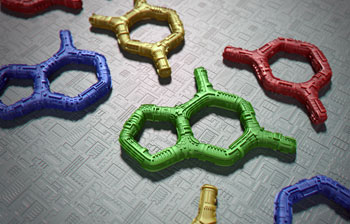Sequins As Novel Internal Controls to Improve Genomic Analysis
By LabMedica International staff writers
Posted on 16 Aug 2016
Researchers have developed an intuitive technology called “Sequins” – synthetic “mirror” DNA sequences that reflect the human genome and can be used to better map, navigate, and analyze complexity within the genome. Currently human genome Sequins are freely available for research.Posted on 16 Aug 2016
Scientists at the Garvan Institute of Medical Research (Darlinghurst, Sydney, NSW, Australia) developed the new technology. “Human genome sequencing is transforming biomedical research and healthcare,” said Dr. Tim Mercer, who led the development of Sequins, “And as genome sequencing is being increasingly used to diagnose disease, it is more important than ever that researchers and clinicians understand the accuracy of the genomic data they are looking at.”

Image: Sequins are small stretches of synthetic DNA to be added as a standardization control to a DNA sample during sequencing, helping analyze the large data files generated for genomic analysis. The technology is based on the notion of mirror image DNA. Sequins are essentially “mirror” images of natural DNA sequences. They behave like natural DNA sequences but can be easily recognized as synthetic (Photo courtesy of Chris Hammang, Garvan Institute of Medical Research).
Dr. Mercer and his team came up with the idea of adding Sequins, small stretches of synthetic DNA, to a patient’s DNA sample during sequencing. These Sequins (or sequencing spike-ins) then act as internal standards, helping researchers analyze the large data files generated during genome sequencing. The technology is based on an intuitively simple concept: the notion of mirror image DNA. “Sequins are, essentially, mirror images of natural DNA sequences. Like us, the genome has a ‘handedness’, and just as our right hand differs from our left hand, sequins differ from natural genome sequences. So sequins behave just like natural genome sequences, but they can be easily recognized as synthetic,” said Dr. Mercer.
When added to a sequencing reaction, sequins provide internal controls with which to assess the sensitivity and accuracy of genome sequencing. “A whole series of steps, first in the lab and then on the computer, are required to sequence a person’s genome or the genes that are expressed in different cells. Sequins are with the person’s DNA every step of the way: responding just as real DNA does at each step, yet unmistakably different from that real DNA. This allows a scientist to assess, and optimize, these different steps.”
Because sequins are added to each individual sample, they can provide a sample-by-sample assessment – something that has not previously been possible. “Sequins are the first technology to allow diagnostic statistics to be applied to each individual genome sequencing test,” said Dr. Mercer, “and we anticipate that their use will improve the reliability and sensitivity of genetic disease diagnosis.”
Cancer diagnosis is one area in which using Sequins should lead to improvements. “Incorporating Sequins into clinical tests for cancer diagnosis will increase the reliability of an individual diagnostic readout, reducing incorrect diagnoses and giving clinicians greater confidence in deciding the best course of treatment for their patient,” said Dr. Mercer.
Using Sequins will also make it possible to directly compare genomic data from research institutes and sequencing centers worldwide. “Sequins bring DNA sequencing to clinical standard, and will be an essential platform for genomic research and medicine,” said co-author Prof. John Mattick, Garvan’s executive director, “This is another important step in advancing Garvan’s mission to bring genomics to the clinic.”
The potential applications of Sequins are many. Because all genomes, from bacteria to human, have handedness, sequins can be similarly designed for any organism, or for almost any next-generation sequencing (NGS) application.
The Sequins technology is described in two linked studies, by Hardwick SA et al and by Deveson IW et al, both published August 8, 2016, in the journal Nature Methods.
Related Links:
Garvan Institute of Medical Research













